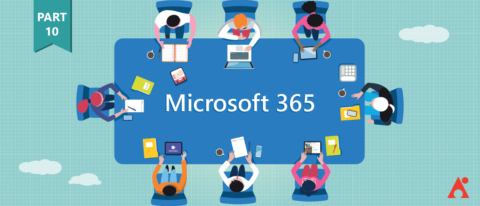4 Vital Microsoft Teams Adoption Questions Answered In-Depth (My Teams #10)


The “My Teams” series is broken into the following categories. Click on one to see the full list of articles in that category:
- The AvePoint Microsoft Teams Story
- Microsoft Teams Case Studies
–How to Make a MAJOR Marketing Splash with Microsoft Teams
–Why This Office 365 Consultant Insists on Using Microsoft Teams
–What Government Agencies NEED to Know Before Running a Microsoft Teams Pilot
- Microsoft Teams Features and Functions
John’s intellectual curiosities and passions are all about driving the adoption of cloud services in large US federal organizations. He’s a delivery architect with hands-on experience and expertise on service adoption, Microsoft Teams, and SharePoint Online. In part ten of this series, we’ll discuss John’s insights on adoption, challenges facing organizations planning to deploy Teams, and experience-driven recommendations.

Name: John S. Moh
Location: Fairfax, Virginia
Current Role: Principal Consultant, Microsoft Services
One word that best describes how you work: Curiously
Mobile device of choice: iPhone XS Max
Computer of choice: Dell Precision 7510
To get started, please tell us a little about your background and how you got to where you are today.
Jumping over from Avanade in early 2005, I started as an Enterprise Strategy Consultant in Microsoft Services in the Washington DC Area. My desire to be more technical then led me to complete the Exchange “Ranger” program (Microsoft Certified Master), landing me on some of the most politically and technically challenging projects in the Public Sector. Eventually, my desire to be globally impactful led me to Redmond where I shipped Xbox Live as a Senior Program Manager.
Today, I’m back in the DC Area working on service adoption, Microsoft Teams, and SharePoint Online solutions to create cookbooks of RSPIs (Reusable Solutions for Productivity and Innovation – pronounced “recipes”). My work can be summed up in this statement: Focus not on use, but the usefulness of cloud services!
How do you engage large federal agencies to look beyond “trendy terms” and understand the true value of “adoption?”
Because adoption is a trending topic and term, let’s “quick format” our understanding and get on the same page. “Delete” everything you’ve heard about adoption and start fresh with the Microsoft Service Adoption Specialist course and certification ?! Service Adoption is Microsoft’s answer to the question our customers, partners, and we have been asking: How do we drive consumption and adoption of Office 365?
In this course, the answer is divided into six critical elements:
- Organizational development
- Business acumen
- Technical competence
- Marketing and communications
- Portfolio management
- Leadership capability
Service adoption is based on Microsoft’s research and is a “how to drive adoption of Microsoft services in your org” framework from the Office 365 Engineering Team. Everyone (engineering, marketing, the field, and the rest of Microsoft) is calibrating to this framework today.
I’ve been curious about technology adoption for a very long time, intentionally taking adoption-focused engagements to gain real-world experience. Service adoption is how I define adoption as it relates to Microsoft cloud services in large federal organizations.

What are the top two challenges to successful Microsoft Teams deployments large federal agencies are facing?
Teamwork culture. We typically use email for everything In large federal organizations, and Outlook has been the hub for teamwork till Microsoft Teams came around recently. Now don’t get me wrong, I still love email (and have spent a good portion of my career focused on it), but with Teams, email becomes MORE valuable, not less. Teams is not a replacement for email; it’s not an or, but an and.
Microsoft Teams can improve teamwork and mission effectiveness with conversations rather than emails and channels rather than file folders, but we need to hinge its release with service adoption. Otherwise, you’ll see users “fighting with the tool” rather than seeing it as a useful tool. “The biggest issue I see across all customers implementing Teams is that they don’t have anyone in their organization dedicated to Service Adoption.” I’m co-signing this statement from Rima’s post ?!
Technical Competence. Driving adoption of Microsoft Teams requires technical competence, and this requirement amplifies in GCC (Government Community Clouds) where technical capabilities and features are different from commercial. For example, we don’t have bots. We also don’t have Flow and PowerApps (yet). We did just get Planner, though, and Stream is coming! As a result, technical competence—the knowledge required to apply a specific technology to a business/mission problem to achieve the desired outcome—is a must-have for anyone driving Teams adoption in large federal organizations. You must understand what’s possible in GCC and set expectations accordingly. Otherwise, you’ll frustrate users.
Planning a Microsoft Teams adoption and need tips? Check out this post: Click To TweetHow do you suggest agencies go beyond end-user training to ensure a successful Microsoft Teams deployment?
I have a bunch of suggestions! For example, agencies should start with the end in mind and focus on small victory laps, splitting governance, and showing more than telling. But if I had to pick one, it would be this: shift learning and support to the left. Like the shift left approach to software testing, it’s about moving learning and support motions as close to the user as possible. Microsoft Teams issues are mostly about learning (knowledge) versus support (breaking/fixing). So, a peer-to-peer support model is a great fit. We’ve used a “player-coach*” analogy successfully in the past:
- A player-coach is an embedded “player” (member) and “coach” (owner) of a Microsoft Teams instance.
- He/she is committed to participating in “train-the-trainer” onboarding, and ongoing learning events with the Microsoft Teams release team.
- Most importantly, a player-coach is willing to serve other members of his/her team as the first level of escalation for learning and support.
We have found that player-coaches speed up resolution times for users, simplify support escalation processes (reducing overhead), and minimize support costs while maximizing the service adoption experience. I recommend shifting left for any large federal organizations getting ready to release Microsoft Teams.
*Note: The term “player-coach” is just an analogy and may not be a fit for your organization’s culture. Please be inclusive and come up with an analogy that fits your context!
What’s your best time-saving shortcut in Microsoft Teams?
There are too many to pick one, but let me practice what we preach and show you rather than tell you:
How do you think cloud services, like Microsoft Teams, will change the face of technology deployments?
In my field, the future of cloud services will pivot on the quality of the adoption experience. To the degree the technology is being commoditized, we must invest in improving the service adoption (people) experience. To this end, we’ll perhaps see new roles in the future… maybe a CSAO “Chief Service Adoption Officer” ?.



